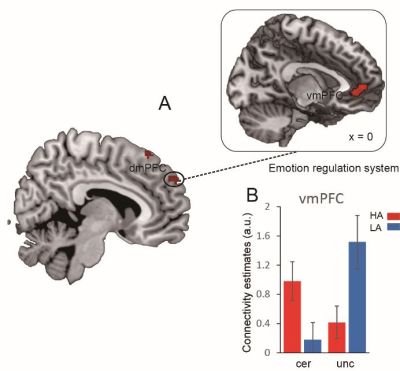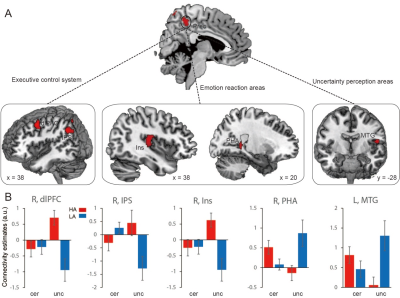2357
Altered brain activation and connectivity during anticipation of uncertain threat in anxiety1Key laboratory of Mental Health, Institute of Psychology, Chinese Academy of Sciences, Beijing, China, 2Shenzhen Key Laboratory of Affective and Social Cognitive Science, Shenzhen University, Shenzhen, China, 3Key laboratory of Behavioral Science, Institute of Psychology, Chinese Academy of Sciences, Beijing, China
Synopsis
In the present study, we used an emotional anticipation paradigm with functional magnetic resonance imaging (fMRI) to examine the anticipation processing of uncertain threat in anxious individuals by employing brain activation and general psychophysiological interactions (gPPI) analysis. Our findings show altered activations in dmPFC, precuneus, thalamus, and MTG; impaired connections of dmPFC-vmPFC, precuneus-FPN, precuneus-MTG, and precuneus-PHA during anticipation of uncertain threat in anxious individuals, which may be involved in estimation of, perception of, and emotional reactions to uncertain threat. All of these altered neural patterns may together contribute to pathology of anxiety. Our study also provides a new insight for neural and behavioral treatments focusing on the dmPFC-vmPFC circuit that underlies uncertainty estimation and emotion regulation in anxiety-related disorders.
INTRODUCTION: In the research field of anxiety, previous studies generally focus on emotional responses to threat. A recent model of emotion proposes that altered anticipation of uncertain threat in the future is related with the development of anxiety1. Behavioral findings have built the relationship between anxiety and distinct anticipatory processes including attention, estimation of threat, and emotional feelings2. However, few studies have characterized the neural organization underlying anticipation of uncertain threat and its role in anxiety. In the current study, we examined anticipation of uncertain threat in anxious individuals by combining an emotional anticipation paradigm with functional magnetic resonance imaging (fMRI). Our aim is to investigate whether individuals with high level of trait anxiety (as an vulnerability factor for anxiety disorders; see Bishop, 20093) would show dysfunction of brain systems involved in anticipation of uncertain threat, including attention, uncertainty estimation, and anticipatory emotional feelings.
METHODS:Thirty-nine participants (Mean ± SD: 23.56 ± 0.30 yrs, 19 Male/20 Female) were included in the study, 18 in the high trait anxiety group and 21 in the low trait anxiety group. During the functional MRI scanning, all participants completed the emotional anticipation task that including a cue for 2 second, a fixation with random from 2 to 8 seconds, and an emotional picture for 2 seconds. For the aversive condition, the cue “X” was always followed by an aversive picture. For the neural condition, the cue “O” was always followed by a neural picture. For uncertainty condition, the cue ‘‘?’’ was followed by either an aversive or neutral picture at exactly a 50/50 ratio. Data preprocessing was performed using Statistical Parametric Mapping 8 (SPM8; Wellcome Trust Centre for Neuroimaging). In the brain activation analysis, a mixed ANOVA analysis was conducted with anticipation (uncertain threat anticipation vs. certainty anticipation) as a within-group factor and group (high vs. low anxiety) as a between-group factor. Furthermore, to examine the modulation effect of trait anxiety on functional connectivity of key regions involved in anticipation of uncertain threat with the rest parts of the brain during the task, we performed the general psychophysiological interaction (gPPI) analysis by using the significant clusters as seeds achieved from the interaction between anticipation and group.
RESULTS: In the activation analysis, we found that high anxious individuals, as comparing with low anxious individuals, showed significantly increased activation in the thalamus, middle temporal gyrus (MTG), and dorsomedial prefrontal cortex (dmPFC), as well as decreased activation in the precuneus, during anticipation of uncertain threat compared to the certain condition (see figure1). In the gPPI analysis, the dmPFC (see figure2) and precuneus (see figure3) involved in anticipation of uncertainty threat showed altered connections with distributed brain areas including the ventromedial prefrontal cortex (vmPFC), dorsolateral prefrontal cortex (dlPFC), inferior parietal sulcus (IPS), insula, para-hippocampus gyrus (PHA), and MTG in anxious individuals.
DISCUSSION: The increased engagement of MTG is consistent with its roles in attentional and perceptional vigilance to uncertain threats, as suggested by previous literature4. The thalamus is a core hub in ‘low road’ emotional path, which is critical for automatic processing of emotional stimulus5. The dmPFC is very important for computation and estimation of uncertainty of potential threat 6. The precuneus serves as a functional hub that involved in self-referential activities and future planning7. Hereby, the trait anxiety alters the brain activation of uncertain threat anticipation, which may be respectively linked to impaired perception, emotion processing and computation of uncertainty. Decreased connectivity between dmPFC and vmPFC found in the present study might imply that the impaired uncertain threat anticipation is probably relative to abnormal emotion regulation in high anxious individuals. The precuneus is consisted of the default mode network (DMN) that is involved in self-processing, and also strongly interacts with the executive control network critical for cognitive and emotional regulation of anxiety8. Increased interaction between these two networks may reflect more efforts of cognitive and emotional regulation in high anxious individuals during anticipating uncertain threat.
CONCLUSION: Taken together, our findings indicate that during the anticipation of uncertain threat, anxious individuals showed widely distributed altered brain activations and functional connectivity, which may be critical for abnormal perception, estimation, and emotion reactions during anticipation of uncertain threat. Our study also provides a new insight for neural and behavioral treatments focusing on the dmPFC-vmPFC circuit that underlies uncertainty estimation and emotion regulation in anxiety-related disorders
Acknowledgements
This research was supported by National Nature Science Foundation of China (31671136, 31530031).References
1.Grupe DW, Nitschke JB. Uncertainty and anticipation in anxiety: an integrated neurobiological and psychological perspective. Nat Rev Neurosci. 2013; 14:488–501.
2. Grillon C, Baas JP, Lissek S, Smith K, Milstein J. Anxious responses to predictable and unpredictable aversive events. Behav Neurosci, 2004; 118:916–924.
3. Bishop SJ. Trait anxiety and impoverished prefrontal control of attention. Nat Neurosci. 2009; 12:92–98.
4. Bjork JM, Hommer DW. Anticipating instrumentally obtained and passively-received rewards: A factorial fMRI investigation. Behav Brain Res 2007; 177:165–170.
5.Mizuno-Matsumoto Y, Hayashi T, Okamoto E, et al. Human-Related Emotional Stimuli Can Cause a Hippocampal and Thalamic Over-Response in People with Unstable Personalities. J Behav Brain Sci. 2013; 3:509–517.
6.Michael E, Gardelle V de, Nevado-Holgado A, Summerfield C. Unreliable Evidence: 2 Sources of Uncertainty During Perceptual Choice. Cereb Cortex. 2015; 25:937–947.
7.Raichle ME, MacLeod AM, Snyder AZ, et al. A default mode of brain function. Proc Natl Acad Sci. 2001; 98:676–682.
8.Fox MD, Snyder AZ, Vincent JL, et al. The human brain is intrinsically organized into dynamic, anticorrelated functional networks. Proc Natl Acad Sci. 2005;102:9673–9678.
Figures

Figure2. Brain region showing significant functional connectivity with dmPFC in interaction effect between anticipation conditions and anxiety groups. (A) Representative clusters show significant connection with dmPFC. (B) Parameter estimates of uncertain condition and certain condition for the high anxiety (coded in red) and low anxiety (coded in blue) group. Notes: vmPFC, ventral-medial prefrontal cortex.


Figure 1. Brain regions showing significant interaction effect between anticipation conditions and anxiety groups. Representative clusters show significant activation (coded in red) in interaction contrast, color bar represents T values. Parameter estimates of uncertain condition and certain condition for the high anxiety (coded in red) and low anxiety (coded in blue) group. Notes: HA, high anxiety; LA, low anxiety; dmPFC, dorso-medial prefrontal cortex; Prec, precuneus; MTG, middle temporal gyrus; L, left; R, right.